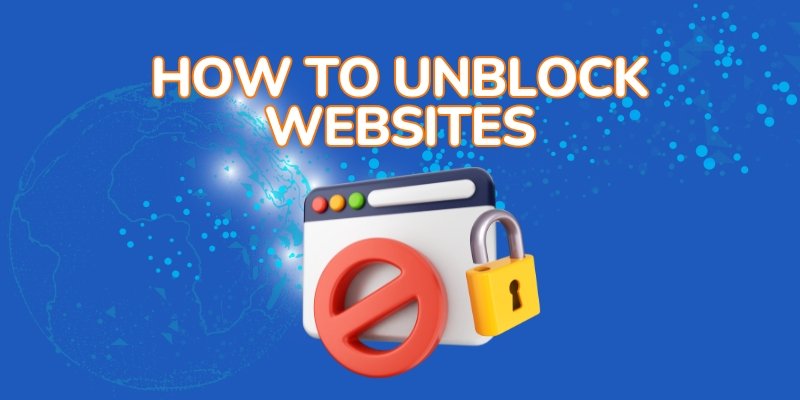It can be annoying when you’re on a network like at school or work and the admins block certain websites. How are you supposed to check what your favorite content creator is eating if you can’t access Instagram? How will you see how many likes your amazing beach selfie got?

Simply use a VPN
VPNs, or virtual private networks, allow you to change your online location and access blocked websites. They work on desktops, laptops and mobile devices. You can change your iPhone’s location with a VPN just as easily as on your home computer.
There are many reasons to use a VPN. For example, changing your YouTube location with a VPN lets you access content that’s not available in your area. If you’re traveling abroad and want to watch Netflix from home, a VPN can make it look like your device is in the U.S. or any other country you choose.

Convenient, right?
However, there are a few things to consider before using a VPN, along with some steps to follow to do it correctly. Don’t worry, we’ve got all the details for you.
Let’s dive into how to unblock websites.
Tip
Any good VPN can help you unblock websites but some are better than others. Private Internet Access, with its strong encryption and affordable prices is one of the best options for unblocking websites.

How to Unblock Websites at School, Work or Home
Is your school’s network blocking YouTube? Can’t check social media at work? Don’t worry we’ve got solutions for your phone, computer or tablet. VPNs can hide your IP address, helping you bypass site blockers and internet censorship. Setting up a VPN is quick and easy.
How to Set Up A VPN
- Choose a VPN: Start with VPN buying guide or check out the best VPNs for school if you’re a student.
- Download the VPN app: Once installed, you can change your device’s IP address and bypass website blockers. If you’re using a school computer, browser extensions might be a better option.
- Sign in: Use your username and password to log in.
- Connect to a VPN server: Choose server locations close to you for the best speeds.
Now that your IP address has changed you should be able to bypass internet censorship even in places like China, known for its strict internet controls.
The best VPNs for unblocking websites offer dynamic IP addresses giving you a new IP address each time you connect to the internet.
VPNs aren’t the only way to access blocked sites.
What Are Proxy Servers?
If you only need to encrypt the IP address of a single web page you can use a free proxy instead of a VPN. The main advantage of proxies is that they are usually free and cover only one website or app. VPNs, however, encrypt all web traffic on your entire device not just your IP address.
For students using school-owned devices, proxies might be a better option. Employees trying to bypass workplace restrictions can use a public web proxy, but keep in mind that your workplace might have blocked these sites as well.
Important
We don’t recommend using these methods to break your workplace rules. If you use proxy servers or a VPN to access restricted content on work devices, your IT department might notice and want to talk to you.
Sometimes, unblocking a website can be as easy as adjusting your device settings.
Change Device Permissions
If you have administrative privileges, you can unblock a website by changing the settings on your computer.
To disable the Microsoft Defender Firewall:
- Click the Windows button.
- Click Settings.
- Click Privacy & Security.
- Click Windows Security.
- Click Firewall & Network Protection.
- Select your profile.
- Scroll to Microsoft Defender Firewall.
- Turn the settings off.

Unblocking Sites on Chrome
On a computer:
- Open Chrome
- Go to Settings
- Scroll down to Privacy & Security
- Click on Site Settings
- Adjust the settings as needed

Unblocking Sites on an Android Device
- Open Chrome
- Go to the website you want to unblock
- Click More (the three dots)
- Click Info
- Click Permissions
- Click Reset Permissions
Alternatively, you can reset permissions for sites like this:
- Open the Chrome app
- Tap the three dots in the right-hand corner
- Select Settings
- Under Advanced, select Site Settings
- Find a site under one of the Permissions categories (such as Location) that is Blocked
- Tap to see a list of sites & change the permission setting
Unblocking Sites on an iPhone or iPad
- Open the Chrome app
- Tap the three dots in the right-hand corner
- Click Settings
- Click Content Settings
- Click the permission you want to change

The Nuclear Option: Tor Browser
If none of the above methods worked you still have the nuclear option.
Tor Browser
The Tor browser is an open-source web browser that hides your location and internet activity, offering great online anonymity. By hiding your location you might be able to bypass firewalls. However, you may not be able to download Tor on school or work computers or in countries like China.
Before diving into the deep web, make sure your screen time limits aren’t the issue.
Turn Off Screen Time Limits
If a website isn’t blocked but you still can’t access it, screen time limits might be the issue. Disabling these limits could help.
On an iPhone
- Open Settings
- Tap Screen Time
- Tap Continue
- Choose either This Is My Device or This Is My Child’s Device
- Enter your passcode if asked
- Tap Content & Privacy Restrictions
- Enter your passcode if asked
- Turn off Content and Privacy

On an Android
- Go to g.co/YourFamily
- Sign in
- Select the child you set screen time limits for
- Select More
- Click Disable
With all of this in mind there are a handful of other ways to bypass web blockers — particularly if they aren’t set up well.
Other Methods for Basic Blockers
Here are some additional ways to unblock websites if you’re dealing with a basic blocker.
- Use an IP Address: Some software blocks domain names but not IP addresses. Try typing the IP address into the URL bar. Use Whois to find the site’s IP address.
- Switch from HTTP to HTTPS: Try typing the URL with either HTTP or HTTPS. Sometimes only one is blocked. However, be cautious as HTTP sites are less secure than HTTPS sites.
- Use a Cached Version: Browsers store copies of sites for faster loading. You might be blocked from the original site but not its cached version. To access a cached site on Chrome:
- Go to Google
- Search for the website
- Click the downward arrow next to the URL
- Click Cached
- Use a URL Shortener: Shortened URLs might bypass blockers.
- Copy the URL you want to visit
- Go to the website URL Shorten
- Paste the URL into the “Shorten Your Link” box
- Copy the short URL
- Paste the short URL into your browser.
Why Are Websites Banned?

For those of us who oppose internet censorship, encountering blocked websites can be frustrating. However, there are various reasons why websites are banned some valid and some not.
Schools
Schools, from elementary to high school, ban websites to control what children can see. This is a legal requirement for any school receiving discounts on internet access through the federal E-Rate program. These schools must follow internet safety policies that block harmful material.
This is part of the Children’s Internet Protection Act, enacted by Congress in 2000, around the time the internet became widely available.
Certain public schools in the U.S. are legally required by the Children’s Internet Protection Act to block obscenity, child pornography and other images harmful to minors.
Besides federal requirements schools block websites to protect kids from obscene content and cyberbullying which affects one in five kids. This often means restricting certain websites and search terms.
Governments
Some governments, like those in China and Russia block websites to silence political opposition, independent journalists and human rights organizations. They may also restrict websites to protect national security, block child pornography or prevent copyright or trademark infringement.
Employers
Employers block websites for several reasons not just to annoy you.
- Preventing Cyberloafing: They want to stop employees from using the internet for personal reasons, known as “cyberloafing” or “cyberslacking.” A survey from OfficeTeam found that employees waste an average of 56 minutes a day online, nearly five hours a week. To prevent time theft, employers may block social media and other non-work-related sites.
- Ensuring Digital Security: Employers also block websites to prevent data breaches or cyberattacks. Human error causes many data breaches with employees often practicing poor digital security and password hygiene:
- One-third save passwords on lists on their devices instead of using encrypted password managers.
- One in five uses the same password for every login.
- Eleven percent fall for phishing emails.
- Only 41 percent of organizations report that all remote employees strictly follow policies on storing and disposing of confidential information.
By blocking certain websites, employers can better control their digital security, beyond just using antivirus software and VPNs for remote workers.
Is It Legal to Unblock Websites?
The legality of unblocking websites depends on your country and the situation.
- Authoritarian Countries: In countries like China and Russia, unblocking banned websites is illegal.
- Schools: If you’re using a school computer governed by the Children’s Internet Protection Act, unblocking websites is also illegal.
- Workplaces: Unblocking websites at work is technically legal but you could be fired for violating workplace policies. Think carefully before risking your job to watch a video or access blocked content.
FAQs
Since internet censorship (and getting around it) is such a huge topic, we’ve answered the most common questions below.
How to Unblock Websites on a School Chromebook?
To unblock websites on a school Chromebook you might need to use a VPN or proxy server depending on the school’s restrictions. Sometimes, changing device permissions can also help.
How to Unblock a Website?
You can unblock a website using various methods like VPNs, proxy servers or adjusting your device’s settings. Sometimes simply changing the URL from HTTP to HTTPS works.
How to Unblock Websites on a School Chromebook Without a VPN?
If you can’t use a VPN on a school Chromebook try using a proxy server or a URL shortener to access blocked websites.
How to Unblock Websites on a Chromebook?
Use a VPN or a proxy server to unblock websites on a Chromebook. You can also try adjusting Chrome’s Site Settings.
How to Unblock Websites on an iPhone?
To unblock websites on an iPhone use a VPN app or adjust the Screen Time settings to remove any restrictions.
How to Unblock a Website on a Mac?
You can unblock websites on a Mac by using a VPN, a proxy server or adjusting the firewall settings. Sometimes changing the browser settings can also help.
How to Make an Unblocked Games Website?
To create an unblocked games website you need to host it on a server that isn’t restricted by firewalls and use a domain name that’s not blacklisted. You may also want to consider using encryption to keep the site accessible.
Final Thought
That’s everything you need to know about unblocking websites and why they’re blocked. We support a free and open internet and hope a VPN helps you bypass firewalls. You can use a VPN on nearly any device including laptops, desktops, cell phones and tablets.
When choosing a VPN, consider the features and prices. Pick one with strong encryption that fits your budget and works on your device.
However, if you’re in a country like China, unblocking websites is at your own risk. While using a VPN is legal in the U.S., it’s not everywhere, so proceed with caution. Always consider the legality and potential consequences of unblocking a site especially in places like school or work where you could face serious repercussions such as being fired, suspended or losing scholarships.
Internet freedom is your right. Claim it.


